Importance of Pollinators
Pollinators assist with plant reproduction by helping to move pollen within or between flowers. Thus, pollinators play a crucial role in supporting biodiversity. Plants serve as the foundations of our ecosystems, and over 80% of flowering plants require pollination services. Pollinators are keystone species that help hold ecosystems together by supporting plant reproduction and plant diversity.
 Three bees native to California: digger bee (Anthophora urbana), Hoplitis fulgida, and Crotch bumble bee (Bombus crotchii). Photos of A. urbana and B. crotchii courtesy of Brooke Goggins; photo of H. fulgida courtesy of US Geological Survey Bee Inventory and Monitoring Lab.
Three bees native to California: digger bee (Anthophora urbana), Hoplitis fulgida, and Crotch bumble bee (Bombus crotchii). Photos of A. urbana and B. crotchii courtesy of Brooke Goggins; photo of H. fulgida courtesy of US Geological Survey Bee Inventory and Monitoring Lab.
In addition to being vital for biodiversity, pollinators support many benefits that humans receive from healthy ecosystems (i.e., ecosystem services)—most notably, food security. They pollinate the flowering plants that produce fruits, vegetables, and nuts. Over 1200 types of crops require pollination, and pollinators contribute an estimated $217 billion to the global economy. In California, pollinator-dependent crops are worth an estimated $11.7 billion. One of the benefits of native pollinators is that they are adapted to local ecosystems, so making use of their pollination services may reduce the need for management and maintenance by famers or other land managers.
Pollinator Biodiversity
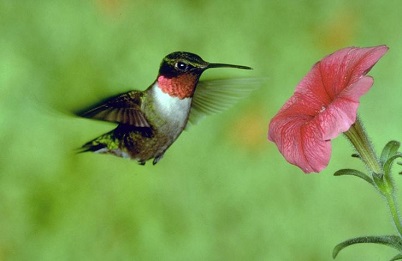 Ruby-throated hummingbird (Archilochus colubris).
Ruby-throated hummingbird (Archilochus colubris).
There are about 350,000 pollinator species in the world. While bees might be the most well-known, other insects, including butterflies, flies, moths, beetles, and wasps, also pollinate. Birds, bats, other small mammals, and lizards can act as pollinators, as well.
Why is it important to have a variety of pollinators? Some pollinators may visit a variety of flowering plants, while certain plants may be pollinated by a range of pollinators. As such, pollinator diversity provides some insurance, in case certain pollinator species are absent in some years. Additionally, some plants and pollinators have co-evolved to have interdependent morphological, behavioral, or phenological traits. Consequently, some plants may require certain types of pollinators to successfully reproduce.
When it comes to native bee biodiversity, California is a global hotspot, with about 1600 native bee species. Pinnacles National Park in Central California has one of the highest densities of native bee species in the U.S. and potentially, the world.
Threats to Pollinators
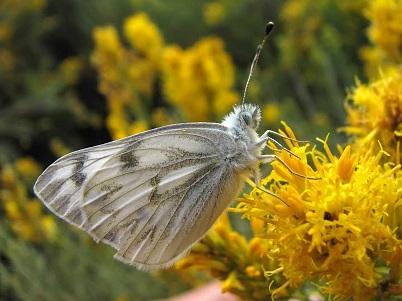 Becker's white butterfly (Pontia beckerii). CDFW photo by Dave Feliz
Becker's white butterfly (Pontia beckerii). CDFW photo by Dave Feliz
Evidence points to a general reduction in pollinator diversity and abundance across multiple spatial scales, worldwide. In North America, some hummingbird, butterfly, and bat species are in decline. One quarter of all bumble bee species are threatened in North America. A review by Forister et al. (2021) found an average annual decline of 1.6% across common and rare butterfly species, in the west. Some have experienced catastrophic declines, such as the western population of monarch butterflies, which has experienced a 99% reduction since the 1980s.
Habitat loss is one of the major threats to pollinators. Pesticide use, disease, parasites, and non-native species also pose risks to pollinators. Climate change can amplify the effects of these stressors on pollinators, including potentially shifting the ranges of plant species and the timing of flowering.
How Can We Help Pollinators?
 Pollinator garden. Photo courtesy of Jeff Silva (CC BY 2.0 via Flickr).
Pollinator garden. Photo courtesy of Jeff Silva (CC BY 2.0 via Flickr).
Since habitat loss is one of the greatest threats to pollinators, habitat protection and restoration are important for supporting pollinator populations. In addition to protecting and restoring large tracts of undeveloped habitat, habitat protection and restoration can include planting hedge rows on farms, cultivating pollinator habitat in home gardens, and contributing to urban greening efforts. Furthermore, creating pollinator habitat along roadsides or riparian corridors helps increase connectivity between patches of habitat and along migratory routes.
Pesticides contribute to declines in pollinator populations, even when pollinators are not targeted. Practicing integrated pest management can help protect pollinator health through ecosystem management that does not rely solely on pesticides.
There are many opportunities to contribute to community science efforts to build baseline datasets for researchers to track pollinator locations and population health:
CDFW Efforts to Help Pollinators
The California Department of Fish and Wildlife (CDFW) manages California’s diverse fish, wildlife, and plant resources, and the habitats upon which they depend, for their ecological values and for their use and enjoyment by the public. Many efforts are underway at CDFW to improve conditions for pollinators, including the following pollinator conservation projects:
Western Monarch Butterfly
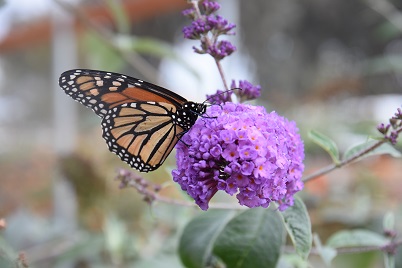 Monarch butterfly (Danaus plexippus plexippus). Photo courtesy of Lisa Cox, US Fish and Wildlife Service).
Monarch butterfly (Danaus plexippus plexippus). Photo courtesy of Lisa Cox, US Fish and Wildlife Service).
CDFW is a member of the Western Association of Fish and Wildlife Agencies’ (WAFWA) Western Monarch Working Group and led development of the 50-year Western Monarch Conservation Plan (PDF), which establishes goals for population size and habitat conservation, strategies, and actions for monarch butterflies overwintering along the California coast and breeding throughout the western US. In support of the WAFWA plan, CDFW is restoring breeding habitat (milkweed) and migratory resources (flowering plants) on over 1,700 acres across the coast range and Central Valley. CDFW is also surveying its properties for milkweed to protect existing stands, and facilitating a plant materials workgroup to increase the availability of native plant species used by monarchs. For additional information on the status of the monarch population and CDFW’s conservation efforts, see the Monarch Butterfly page.
Bumble Bees
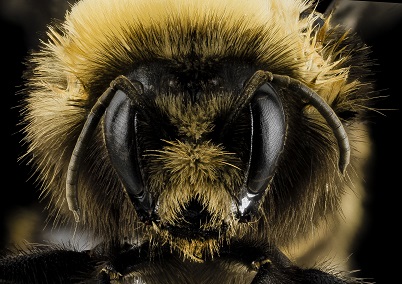 Western bumble bee (Bombus occidentalis occidentalis). Photo courtesy of US Geological Survey Bee Inventory and Monitoring Lab.
Western bumble bee (Bombus occidentalis occidentalis). Photo courtesy of US Geological Survey Bee Inventory and Monitoring Lab.
Bumble bees are critically important because they pollinate a wide range of plants over the life cycles of their colonies, which typically live longer than most native solitary bee species. They are also one of the few types of pollinators that are capable of buzz-pollination (vibrating at a frequency that releases pollen from particular plant species). Globally, many bumble bee species are in decline. In California, information about bumble bee abundance and distribution is limited, but it suggests that some species have declined, in alignment with global trends. To help fill this data gap, CDFW has partnered with the Xerces Society to create a community science-driven California Bumble Bee Atlas that will launch later this year.
Bats
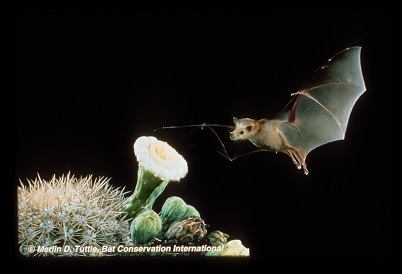 Lesser long-nosed bat (Leptonycteris yerbabuenae). Photo courtesy of Merlin D. Tuttle, Bat Conservation International.
Lesser long-nosed bat (Leptonycteris yerbabuenae). Photo courtesy of Merlin D. Tuttle, Bat Conservation International.
Although most of California’s 25 bat species are insectivores, two species, the lesser long-nosed bat (Leptonycteris yerbabuenae), and the Mexican long-tongued bat (Choeronycteris mexicana), primarily forage on nectar and pollen. These species are important pollinators of agaves and large cacti in southwestern North America. CDFW is engaged with partners from other states, federal agencies, and non-governmental organizations to monitor bat populations, through the North American Bat Monitoring Program (NABat). NABat uses a variety of techniques, including acoustic monitoring and roost counts, to assess distributions and other trends of bat populations in Canada, the US, and Mexico. For example, white-nose syndrome is a disease caused by the fungus Pseudogymnoascus destructans. It has killed over six million bats in the eastern US. CDFW leads the California White-Nose Syndrome Steering Committee, a multi-agency scientific research group that has been monitoring the syndrome across the US since 2009. In 2019, CDFW and US Fish and Wildlife Service announced that the fungus was likely present in California. CDFW continues to work with US Fish and Wildlife Service, as well as other partners, to monitor for the fungus and disease, in places where bats hibernate. CDFW is also working on the California Bat Conservation Plan, an in-depth assessment of the conservation threats and best management practices for all of California’s bats, including pollinator species. The Conservation Plan should be finalized by 2022.
- US Fish and Wildlife Service’s pollinator website
- Pollinator Partnership website
- Natural Resources Conservation Service's insects and pollinators website
- Xerces Society's Pollinator Conservation Resources for California
- University of California Agriculture and Natural Resources Pollen Nation website
- Report on status of pollinators in North America
- Ollerton, Jeff. "Pollinator diversity: distribution, ecological function, and conservation." Annual Review of Ecology, Evolution, and Systematics 48 (2017)
- Meiners, Joan M., Terry L. Griswold, and Olivia Messinger Carril. "Decades of native bee biodiversity surveys at Pinnacles National Park highlight the importance of monitoring natural areas over time." PloS one 14.1 (2019): e0207566
- Guidance about pesticide use, habitat management options, funding opportunities, and general regulatory information (PDF)